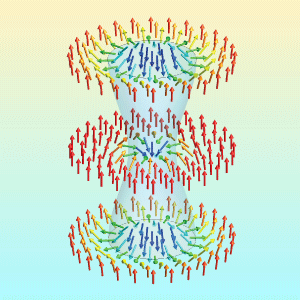Scientists identify new way of information storage and processing based on skyrmions
Hard to unwind like knots in a rope, magnetic skyrmions are stable magnetic whirls that behave like tiny particles in magnetic thin films. These whirls, only a few nanometers in size offer great potential for next-generation information storage and processing.
In order to unleash their extraordinary potential as information carriers, control of individual skyrmions has to be achieved. So far, this has only been shown for a very rare and exotic class of materials where an unusual chiral exchange interaction called the Dzyaloshinskii-Moriya interaction (DMI) plays an important role.
 According to findings published in the (opens in a new window)scientific journal Nature Communications, a team of international scientists from Ireland, Sweden, Switzerland and China has discovered that skyrmions can be dynamically stabilised in ultra-thin films by their own precessional motion without the need for DMI, not unlike a spinning top. This discovery means that a wider range of materials are now open to possible use for next generation information storage and processing.
According to findings published in the (opens in a new window)scientific journal Nature Communications, a team of international scientists from Ireland, Sweden, Switzerland and China has discovered that skyrmions can be dynamically stabilised in ultra-thin films by their own precessional motion without the need for DMI, not unlike a spinning top. This discovery means that a wider range of materials are now open to possible use for next generation information storage and processing.
“Based on extensive numerical simulations and analytical theory, we considered the creation of a skyrmion under nanocontact, where a spin polarized current is injected into the magnetic thin film providing torque to its magnetic moments,” said Professor Hans-Benjamin Braun who carried out the work at UCD School of Physics, University College Dublin, and ETH Zurich. He developed the analytical theory and co-led the research with Professor Johan Åkerman from the (opens in a new window)University of Gothenburg in Sweden.
“Our findings show how dynamic skyrmions can be nucleated, sustained, and manipulated under a nanocontact. As quasiparticles, they can be transported between two well separated nanocontacts, even in complete absence of DMI,” Professor Braun added.
This offers the possibility to create and control skyrmions in materials that have so far been considered unsuitable for next-generation information storage and processing according to first-author Yan Zhou from the University of Hong Kong who carried out most of the detailed simulation studies.
“Breathing dynamical skyrmions in spin torque oscillators are powerful sources of microwave generation,” Professor Johan Åkerman said. “They have an output power that is orders of magnitude higher than conventional precessional spin torque oscillators and their frequency can be tuned via the injection current making them attractive for broadband applications.”
Spin-based information processing will require much less power than its conventional electron-based counterpart. This is an important issue for society as the current global IT infrastructure is producing excessive heat resulting in a carbon footprint exceeding that of worldwide air traffic.
Pictured above: Graphical representation of a magnetic skyrmion (Image: Hans-Benjamin Braun, UCD)
More information: Y. Zhou, E. Iacocca, A.A. Awad, R.K. Dumas, F.C Zhang, H.B. Braun, J Åkerman, Dynamically stabilized magnetic skyrmions, Nature Communications, DOI: 10.1038/ncomms9193UCD academics on The Conversation
- Opinion: The leap year is February 29, not December 32 due to a Roman calendar quirk – and fastidious medieval monks
- Opinion: Nigeria’s ban on alcohol sold in small sachets will help tackle underage drinking
- Opinion: Nostalgia in politics - Pan-European study sheds light on how (and why) parties appeal to the past in their election campaigns






